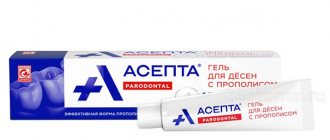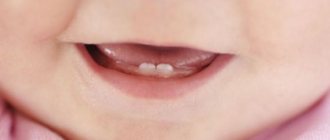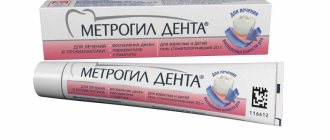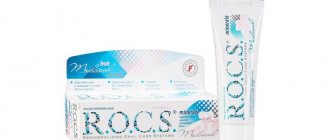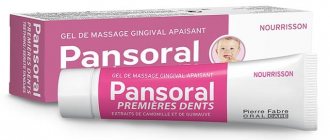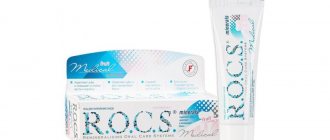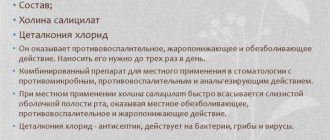From this article you will learn:
- instructions for use, reviews,
- price for Asepta gel in pharmacies,
- differences in composition between Asepta gel and balm.
Asepta gum gel is a dental preparation in gel form used to treat inflammation of the oral mucosa and gums. This drug is the only gel for gums in Russian pharmacies, whose active component is a beekeeping product - propolis. It should be noted that this drug is not registered as a “drug” and therefore it belongs only to the “parapharmaceutical” category.
The drug is produced in Russia. Inside the cardboard package (in addition to the tube with the gel) there is a plastic spatula intended for applying the gel to the gums. You may feel a little weird at first when using this applicator to apply gel to your gums, but it actually does a better job than using your finger. In addition to Asepta gel, there is also ASEPTA in the form of an adhesive balm. This drug no longer contains propolis, but a combination of the antibiotic metronidazole and the antiseptic chlorhexidine (Fig. 2).
ASEPTA in the form of gel and balm for gums: photo
Asepta gum balm, thanks to chlorhexidine and metronidazole, has a much more pronounced antimicrobial effect on pathogenic microflora. This drug will be much more effective in the acute phase of inflammation - compared to its propolis-based version. You can read more about adhesive gum balm here , and in this article we will focus in detail on the gel form.
Indications for use –
- with gingivitis,
- with periodontitis,
- trophic ulcers of the oral mucosa,
- for stomatitis (for epithelization of erosions/aphthae).
Instructions for using Asepta gum gel contain all of the above indications, but not with all of them - you can get a good effect. Each of these indications requires clarification, and therefore we will analyze in detail in our article all the features of using this gel in the treatment of inflammatory processes in the oral cavity.
Content:
- Active substance
- Indications for use
- How to use it correctly
- Benefits of the medicine
- Contraindications
In the treatment of many dental diseases, doctors use local anti-inflammatory drugs.
They have an impact directly on the source of inflammation, thanks to which the doctor quickly gets positive results. The drug Asepta, made from the waste product of bees, is in particular demand in dental practice. It is produced by a Russian pharmaceutical company. In pharmacies, the product can be purchased in the form of a gel located inside a plastic tube. The kit includes a small spatula applicator for convenient use of the medicine.
Which gel is best for baby's gums?
The choice of gels in pharmacies today is quite wide. You can choose homeopathic, anesthetic, and antiseptic remedies.
For moderate inflammation, it is better to choose drugs with extracts of medicinal plants.
Anesthetic gels should be used only for severe inflammation, if the child cannot cope with unbearable pain. Painkillers with lidocaine or benzocaine act instantly, in just a few hours.
However, all such anesthetics can cause numbness of the tongue, which means making sucking difficult and ruining the baby’s appetite. Therefore, their use is advisable only in extreme cases.
In case of inflammation, it is recommended to lubricate the site of infection with antiseptic ointments and gels. The products not only eliminate foci of inflammation, but also stop the proliferation of bacteria.
Active substance
The official instructions indicate that the gum base contains only one active ingredient - propolis. As is known, it has antimicrobial, anti-inflammatory, analgesic and antipruritic properties, and exhibits pronounced activity against gram-positive bacteria.
The composition with propolis accelerates regeneration, promotes rapid epithelization of wound surfaces in the mouth, and supports the normal course of metabolic processes. Studies have shown that it reduces gum inflammation by 31%.
The medicinal effect of the beekeeping product is explained by the presence in it of a number of biologically active organic compounds. They have a direct effect on oral tissues and pathogenic bacteria, thereby ensuring positive results in the treatment of a wide variety of dental ailments.
Main properties of propolis:
- Significantly reduces or completely eliminates pain and discomfort in the gums. But you need to understand that pain relief is not an easy task. With severe pain symptoms, it will not be possible to do without analgesics. The analgesic effect of Asept gel manifests itself gradually, so it is important not to forget to re-treat the gums in a timely manner.
- Fights inflammation, provides excellent prevention of purulent and necrotic processes. Reduces the severity of swelling, removes redness, normalizes the temperature in the damaged area and helps restore full blood circulation.
- Destroys pathogenic microflora. Doctors refer to the “creation of bees” as a natural antibiotic. It does not disturb the natural microflora of the oral cavity and does not cause undesirable consequences.
- Accelerates wound healing. With regular use of the medicine, wounds and ulcers heal much faster. Inflammation subsides already on the second or third day of treatment.
Taken together, these properties make propolis an important assistant for dentists. If you have been prescribed this drug, listen to your doctor’s opinion - Asepta copes with a wide variety of lesions.
ASEPTA gum balm –
The drug Asepta gum balm (instructions) contains antimicrobial components - the antibiotic metronidazole 1.0% and the antiseptic chlorhexidine 0.1%, which act on pathogenic bacteria that cause inflammation of the gums. In addition, ASEPTA adhesive balm for gums contains pectin and cellulose, which, when released into the moist environment of the oral cavity, acquire the consistency of a gel (thanks to this, the drug is well fixed on the mucous membrane).
Asepta gum balm - reviews are no different from reviews of a drug such as MetrogilDenta. Both drugs are of average effectiveness and contain only antimicrobial components (do not contain anti-inflammatory components). It should be noted that Asepta balm contains 2 times more concentration of chlorhexidine - in comparison with Metrogil denta, but they have the same concentration of metronidazole. We hope that our article: Balm and gel ASEPTA price and reviews was useful to you!
Sources:
1. Add. professional
, 2. Based on personal experience as a periodontist, 3. https://asepta.ru/, 4. “Therapeutic dentistry. Textbook" (Borovsky E.V.).
Indications for use
Dentists recommend using the medication for:
- Gingivitis is inflammation of the gums. It manifests itself as swelling, pain, redness, and bad breath. The product blocks the further spread of inflammation, heals tissues and accelerates their healing. It can be used as monotherapy only at the initial stage of gingivitis. If the disease is advanced, the gel should act as a concomitant therapy.
- Periodontitis. A dangerous disease that causes disruption of the periodontal junction. Promotes loosening and premature tooth loss. The remedy for periodontitis is prescribed at the final stage of treatment - when the formed periodontal pockets are cleaned and treated. "Asepta" allows you to speed up recovery and shorten the patient's rehabilitation period.
- Trophic ulcers in the mouth. With this diagnosis, ulcerative lesions that are painful to the touch are formed on the mucous membranes. In the absence of timely treatment, the area of damaged tissue increases, and regional lymph nodes become inflamed. The medication helps at any stage of the ulcerative process. They must be treated according to the scheme specified by the doctor.
- Stomatitis (except for aphthous form). A pathology in which the mucous membranes of the mouth become inflamed. First, small inflamed ulcers appear, which gradually increase in size. It is necessary to start treating them as early as possible, then the abnormal process will not have time to spread widely. “Asepta” for stomatitis should be combined with antiviral drugs.
- Mechanical damage to the gums. Inflammation is often a consequence of dental procedures, rubbing of dentures, eating too hard foods, and the habit of gnawing on foreign objects. To prevent secondary infection and other complications, you should start using the gel composition immediately after the integrity of the mucous membrane is damaged. Then healing will take place much faster.
Since the drug is made on the basis of natural compounds and has a high safety profile, it can be used to prevent gingivitis and periodontitis if there is a tendency to these diseases.
What else can you do to help your baby?
When teething, a baby can be helped not only with the help of gels. Effective pain relievers can be:
- Gum massage.
Massage relieves itching, tension in soft tissues, and also activates blood circulation, reduces itching and swelling, and helps teeth erupt faster. - The teether
will allow your baby to massage his gums on his own. And if you keep the item in the refrigerator, it will provide pleasant cooling to the gums. - Mouth lotions
will help relieve inflammation in the mouth. To make them, you can use chamomile, calendula or sage.
For gentle oral hygiene of babies and massage of the gums during the eruption of the first teeth, ASEPTA BABY finger wipes with xylitol, extracts of chamomile, witch hazel, green tea and calcium pantothenate are perfect. These ribbed wipes can be used to gently massage your gums to reduce teething discomfort. The wipes will also allow the baby and mother to develop the habit of daily oral hygiene and, importantly, brush their teeth on the go.
To survive the difficult period of teething, it is important to distract the baby’s attention from the pain: talk to him, carry him in his arms, play, soothe him. Patience, love and communication can relieve discomfort no worse than medicine.
Sources:
- Study of the clinical effectiveness of the use of therapeutic and prophylactic agents of the ASEPTA series in the treatment of inflammatory periodontal diseases in children and adolescents (I.V. Klimova) Irina Vladimirovna Klimova, Candidate of Medical Sciences, Associate Professor of the Department of Pediatric Dentistry, Novosibirsk State Medical University. Department of Pediatric Dentistry, Novosibirsk State Medical University.
- The effectiveness of the use of Asept “adhesive balm” and Asept “gel with propolis” in the treatment of chronic generalized periodontitis and gingivitis in the acute stage (Municipal Dental Clinic No. 4, Bryansk, Kaminskaya T. M. Head of the therapeutic department Kaminskaya Tatyana Mikhailovna MUZ City Dental Clinic No. 4, Bryansk
- Clinical experience in using the Asepta series of products Fuchs Elena Ivanovna Assistant of the Department of Therapeutic and Pediatric Dentistry State Budgetary Educational Institution of Higher Professional Education Ryazan State Medical University named after Academician I.P. Pavlova of the Ministry of Health and Social Development of the Russian Federation (GBOU VPO RyazSMU Ministry of Health and Social Development of Russia)
How to use it correctly
The instructions say that the composition must be applied to the gums and affected areas of the oral mucosa in a thin layer. You can do this with your finger (be sure to wash your hands first!) or using a special applicator.
You should not eat or drink anything for half an hour after treatment. Otherwise, the medicine will not have time to work. Frequency of use: two or three times a day. The duration of the course should be from seven to fourteen days. For prevention purposes, it is recommended to use the drug two to three times a year.
Benefits of the medicine
In addition to affordable cost and high efficiency, the gel has other advantages:
- The soft gel texture allows it to be applied evenly and easily distributed even in hard-to-reach areas of the mouth. The product is suitable for spot treatment of fabrics.
- The neutral taste does not cause discomfort during therapeutic procedures.
- The presence of an applicator in the kit allows for processing in compliance with established aseptic requirements.
- The product has passed the necessary clinical tests, which confirmed its safety and effectiveness.
- Can be used for various dental diagnoses. It combines well with other medications.
Contraindications
The components present in the composition do not have a systemic effect on the body. In rare cases, patients develop allergic reactions during the treatment course. For this reason, Asepta is not prescribed for aphthous stomatitis, since if an allergy develops, the course of the disease worsens sharply.
An absolute contraindication to the use of the drug is individual intolerance to bee products. After all, the basis of the medicine is propolis.
As for therapy during pregnancy and lactation, it is also not recommended. But not because the medicine is dangerous for this category of patients, but because the necessary clinical studies on this issue have not yet been carried out.
It is important to understand: Although Asepta prevents the proliferation of pathogenic microflora, it does not replace standard hygiene procedures. Therefore, it is important to regularly use a toothbrush and toothpaste during treatment.
How do teeth start cutting?
Typically, a baby's first tooth appears by 6-8 months. However, some babies have their first incisors by 4 months, and some don't have them until they're one year old.
The timing of the appearance of teeth depends on heredity, as well as on the course of pregnancy in the mother. The condition of the teeth is influenced by the mother’s lifestyle and diet during the first trimester of pregnancy and at the beginning of the second.
Remember: the age at which teeth appear does not affect their quality in any way.
A full set of baby teeth is formed in children by the age of 2-2.5 years and, alas, before this, the baby from time to time feels discomfort in the mouth. Some people's teeth grow almost imperceptibly, while others constantly feel pain and need medical help.
The main symptoms of teething in children are:
- loud crying, restless behavior of the baby;
- temperature increase;
- redness, swelling of the gums;
- itching in the gums;
- in rare cases, hematomas appear on the gums;
- excessive salivation;
- poor appetite;
- deterioration of sleep.
In 95% of children, baby teeth grow in the following order:
- the two lower incisors erupt, as a rule, by 6-8 months;
- the two upper incisors grow a month after the lower ones;
- the upper and lower lateral incisors grow by 10 months;
- molars appear between one year and 15 months;
- the upper and lower canines grow 2 months after the molars;
- second molars grow from 2 to 3 years of age.
The most painful experience for children is the appearance of their first incisors and large molars. As they grow, the baby becomes whiny, restless, and may develop a fever and diarrhea. The child constantly clutches his cheeks and cries.
